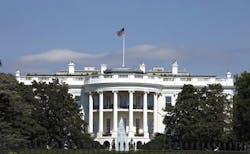Infrastructure and the Next Administration
By Andy Fraher
As we approach the 2016 presidential election, the increasing U.S. infrastructure investment gap has emerged as a focus area for the respective Republican and Democratic candidates. According to Reuters, an American Society of Civil Engineers (ASCE) report released in May indicates that the U.S. will fall short of its needs by $1.44 trillion through the end of the next decade.
Half of all registered voters believe infrastructure has deteriorated over the past five years and this belief is shared by Democrats and Republicans alike. Both the House and Senate appear in agreement that the nation’s infrastructure demands attention in the form of a robust federal investment program. Additionally, the Association of Equipment Manufacturers reported that between 80 and 90 percent of voters believe that infrastructure (including water) is in need of some or extreme repairs and that government attention is required.
Senator Clinton has stated that she wants to enact within her first 100 days an infrastructure bank that would rival the Eisenhower National Highway System program and would invest $275 billion for all manner of infrastructure, including water. Donald Trump has said he will double down on the funding level, seeking $500 billion (although it is unclear how the funding would be derived). Regardless of who wins, in Congress we see a number of signs pointing to the recognition that we must dedicate resources for infrastructure - and specifically water.
The U.S. EPA spending bill in the House states that a robust federal commitment to the State Revolving Loan Fund (SRF) is vital. At the same time, the House bill notes that Public-Private Partnerships (P3s) and private activity bonds and other innovative funding approaches must be used to help bridge the gap. The Senate and the House provide as much as $45 million and $35 million, respectively, to support the Water Infrastructure Finance and Innovation Act (WIFIA) program for the first time, which would result in as much as $4 billion in new spending. The Senate WRDA 2016 bill provides for WIFIA to become a permanent program (not a pilot program as is the case today) and would require the Treasury to commit another $70 million in funding immediately upon enactment of WRDA, providing for another $8-9 billion in new spending.
From a regional perspective, drought relief bills addressing western drought are pending that would, if enacted, provide for at least another $0.5 billion in spending for water recycling and desalination projects, as well as limited R&D grants to support water technology.
As was the case during the Great Depression, lawmakers recognize the inherent benefit of using infrastructure policy to increase economic activity across the nation and create new jobs. As a result, any infrastructure policymaking will inevitably touch on regulatory mandates (such as Buy American) and compliance issues that in turn will impact any and all forms of assistance whether a grant, loan, loan guarantee, or private activity bonds that allow for tax exempt status. Additionally, when one reviews the implementation of U.S. EPA’s WIFIA program (and perhaps subsequent use by the U.S. Army Corps of Engineers) it is clear that the current Buy American (BA)/American Iron and Steel (AIS) policy is here to stay. The U.S. EPA indicates that it intends to implement the SRF BA/AIS rules in future WIFIA assistance.
As the Water and Wastewater Equipment Manufacturers Association (WWEMA) and other associations provide a critical industry voice to any infrastructure initiatives, it will be WWEMA’s top priority to ensure that any legislation that may be developed in the coming years provides a clear statement that limited federal infrastructure assistance resources must be utilized in the most efficient and effective manner possible. This must be the basis for how assistance is allocated to ensure that: 1) the implementation of the most innovative technologies that can reduce costs and energy and improve public health are maximized; and 2) that if BA/AIS is mandated, any policy must provide that compliance does not result in increased costs to the public, which in turn will most certainly result in the reduction of scarce resources required to address the increasing U.S. infrastructure investment gap.
About the Author: Andy Fraher is director of marketing and business development, North America, for Xylem Inc. and is the chair of the Water and Wastewater Equipment Manufacturers Association’s Buy American Subcommittee. For more information on WWEMA go to www.wwema.org.

